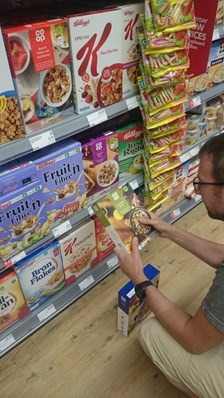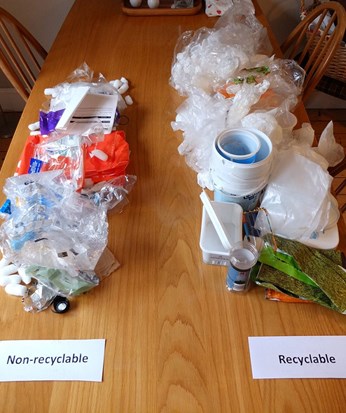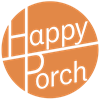Plastic Free July – two voices from the team
Plastic Free July – Tom
When Simone asked the rest of the team about taking part in Plastic Free July, I did think it would be a good and interesting challenge.
Convincing my wife Jenny to take part as well wasn’t hard, since we’re both increasingly more aware of the environmental impact that the products we buy have, and we already try to find more sustainable options. So to spend a month trying to live with less plastic seemed like a no-brainer.
At the start of the month we decided to keep a separate bin bag to one side and collect all the plastic that we would still get, so we could see at the end of the month how well (or not) we had done.
When it comes to taking part in Plastic Free July there seem to be a few different ‘strategies’; some people will cut out a single thing for month (like takeaway coffees), some people will focus on a particular area in their house/life (like food packaging, or cosmetics) and the real hardcore people will refuse all plastics for a month (even if that means giving up on some of their favourite things).
We decided to look at all areas of our life and see where we could reduce our plastic usage in a relatively sensible way.
In a way we had already started this process, since earlier this year we swapped from buying milk in plastic bottles from the supermarket to getting milk delivered by the local milkman in glass bottles (which they collect once empty and reuse). That switch was partially due to us getting more aware of plastic, but also wanting to support local businesses and farmers more (there are a lot of dairy farmers in Cheshire where we live).
And using single-use plastic bags to carry our shopping in has been something we haven’t done for a while either. England only started charging for plastic bags in 2015, but we also lived in Wales for a while where they have been doing this since 2011. And even before that, in the Netherlands, where I am from, it’s been common to take your own bags when shopping for as long as I remember. So it was easy for us to get into that habit here before it became a necessity.
One of the first things we did was to make some beeswax wraps to reduce the need for cling film to wrap food in. Since Jenny is a textile conservator and also a keen sewer, getting hold of some spare pieces of cloth was easy. And the local household store in our town was selling beeswax bars (with no packaging!). The process of grating the beeswax and applying it to the cloth with an iron was pretty straightforward as well.
Then we looked at some of the food items we buy and use most.
Tea bags still contain a small amount of plastic in most cases (there are a few brands now introducing biodegradable bags), so we decided to swap to loose leaf tea instead. It still comes in a plastic bag though, so not fully plastic-free there.
And with a cup of tea you obviously want a biscuit as well. We looked really hard for it, but it seems all biscuits come in some form of plastic wrapping (to keep them fresh and crunchy I guess). Thankfully Jenny’s baking skills came to the rescue here, so during the month she baked a few batches of homemade biscuits (which were yummy!).
We both like eating cereal for our breakfast and this posed another challenge. Like the biscuits they all seem to come in a plastic bag inside a cardboard box. Unfortunately we don’t have a store nearby that allows you to buy things in bulk using your own packaging, since that would’ve been a good alternative.
We had a look around various brands in different supermarkets, and most of them seem to use plastic that isn’t currently being recycled. But the local Coop supermarket did seem to stock a few of their own-brand cereals in plastic bags that are recyclable. Interestingly enough, not all of their varieties use these bags and after asking them about it on Twitter it turns out that they’re still in the process of swapping over: https: //twitter.com/Jenny_barsby/status/1013156805244047360
So not completely plastic-free, but at least this plastic bag doesn’t go straight to landfill.

Another surprisingly easy change was when buying bread. We already buy our bread from the local bakers, but it does come in a plastic bag. We pondered various different options and in the end decided to wash the bags the bread comes in once we had finished it and then take those back to the store and ask them to put the new loaves in there. The staff did this without any hesitation, which was great since it can be awkward to ask people to do something differently to the norm.
And so we continued through the month with both ups and downs; yoghurt was impossible to find without plastic pots, so instead we opted for the larger 1kg tubs with the idea being that we would at least be buying fewer pots. But after the first attempt I realised that the alternative yoghurt brand was coming from Germany which isn’t so good if you think about food miles (eventually we did find a British brand that does the larger pots).
Another thing we struggled with was rice and pasta. Both seem to always come in a plastic bag. Which doesn’t really make sense, since you can easily get risotto rice and lasagna sheets in cardboard boxes (without any plastic). Let’s hope manufacturers will switch over to cardboard boxes soon for all pasta and rice. And keep out any plastic windows often found in cardboard boxes, as if we don’t know what rice looks like.
On the flipside of that, a nice surprise was to find another supermarket starting stocking Simply Gum, which is a plastic-free chewing gum (yes, most other chewing gums are using a plastic-based gum so you’re basically chewing a piece of plastic).
Apart from the food we also looked at replacing some of our toiletries.
We made some hand soap and shower gel using castile soap (soap concentrate) so we wouldn’t have to buy new plastic bottles. We tried out toothpaste in tablet-form; you chew the small tablet in your mouth and it starts foaming like a normal toothpaste and you can then brush like normal. The bottle the tabs come in is a plastic bottle, but it’s recyclable and the lid can be taken back to the shop for re-use. And we used some shampoo bars as a replacement for normal bottled shampoo. All of these replacements have worked really well and we’ll probably continue to use those.

So we got to the end of the month and when making up the balance from our plastic bin bag, we concluded that there was definitely less plastic than normal. And the majority of those plastics could be recycled, which is a good thing.
The pile of unrecyclable plastics was largely made up of items we couldn’t find an alternative for (e.g. pasta and rice) and even some unwanted plastics (e.g. charity cloth donation bags put through the letterbox, packaging pellets from something we ordered online).

So how do we feel it went? I think it made a positive impact on our lives and we will definitely keep using quite a few of the things we swapped. It has also made us much more aware of plastic packaging and every time we pick something up in store now we actually look at it to see if it contains non-recyclable plastics and weigh up the alternatives.
But one important thing to highlight here as well is privilege. We’re in the fortunate position that we can spend the time researching and finding alternatives (yes, we did visit about five different supermarkets and various other local shops on our quests) and can also afford some of those alternatives, since they’re often more expensive. For a lot of other people that would simply not be possible.
And our little experiment for a month is only a drop in the ocean. In order to make a real impact in the reduction of single-use plastics we really need to start putting pressure on manufacturers and governments to take action. It will only be by changing things at a larger scale that the price difference between cheap plastic packaging and the more expensive, but more sustainable, alternatives can come down and it will become affordable and more widely available to everyone.
So the journey has probably only just started…
Plastic Free July – Simone
This is my second (single-use) Plastic Free July and it made me feel much less alone when I discovered the rest of the team, especially Tom, were keen to join me. It was really positive to have Barry actively join me in Plastic Free July this year. Last year he supported me and while that’s great, it’s not exactly the same as feeling it for yourself.
We made a number of changes last year that have stuck with us. Like Tom and Jenny, I made some beeswax wraps, have been using my own fabric carry bags for shopping and homemade biscuits are the best!
We were really lucky to be living in Melbourne, with a number of The Source Bulkfoods stores around. We wouldn’t have been able to get through Plastic Free July so easily without it. From The Source I was able to get all the ingredients to make muesli, dried fruit and nuts for snacks, even loose leaf tea. Although, it didn’t save plastic, we started refilling bottles of olive oil, maple syrup and jars of honey here too. Plastic free made us much more aware of all packaging.
Our fresh fruit and vegetables we had delivered in cardboard boxes. I found the company we used in Melbourne, Ceres, was better in terms of packaging than the company we used in Edinburgh. A couple of items have rubber bands but everything else is loose or in paper bags.
Who Gives a Crap toilet paper, rolls which are wrapped in paper and delivered in a cardboard box is accessible in the UK and Australia. I was disappointed to find that in Australia they are now selling bundles of six wrapped in plastic. I’d still support them in buying bulk but I wouldn’t buy their six pack.
We’ve been using shampoo bars since last year but found it trickier to find in Australia without adding on large postage costs. We switched to bamboo toothbrushes but didn’t go as far as Tom with the toothpaste. I used glass bottles of oil for moisturising. We also used bar soap. I’d love to make my own so might need to have a ‘craft weekend’ with Tom and Jenny!
Cheese was our biggest challenge in Melbourne. It was easy to find cheese in wax in Scotland but infinitely harder in Melbourne and it took us 3 weeks and 5 suburbs to find some. Milk is also tricky but not impossible as there are some varieties which come in cardboard. Choosing the cardboard milk often meant that we didn’t choose organic, or small dairy options. Plastic was our focus in July but we might make other choices at other times of year, in terms of supporting small enterprises or thinking about food miles.
Barry and I were looking after pets a lot and it was largely a plastic free fail when it came to animal waste. We failed when visiting other people as well – it was kind of hard to say no to the Celebrations chocolate bars…
Living in a large city like Melbourne certainly gave us more options. Although, there were much shorter distances to cover in Edinburgh if I had to find something!
Overall, I think we did pretty well and some more good, plastic-free habits have become part of our lifestyle. I can see how we will choose ease and convenience at times in the future though. It would be great to keep our plastic from June before we start again next year.
I also recognise that it’s a privilege to ‘deprive’ yourself of plastic. Some of the plastic free alternatives more expensive so I’m sorry it’s not as accessible to everyone. Barry and I are lucky that we have the kind of lifestyle and income to make these choices.
We also totally agree with Tom that this is just a drop in the ocean, but it is fun and rewarding to be part of a general move in a positive direction reducing plastic waste!
